I’m bringing along 2 beautiful German 3/4 violins c.1930 that will be sent to Little Rock Arkansas. The player studies with Drew Irvin , Concertmaster of the symphony. I worked on these inside and out in the same way that I would to any violin that I offer for sale. In fact , I’ve learned over time to bring the same exacting approach to every instrument I take on….everything is an opportunity for magic. I have many 3/4 violins ( and cellos) to offer for sale …from more modest than these all the way to some very special 19th century instruments. I offer full trade in as the player moves upward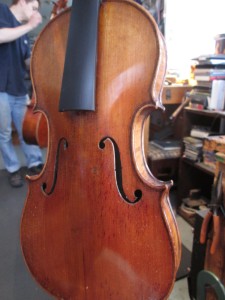
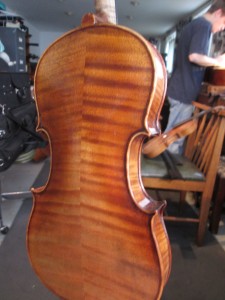
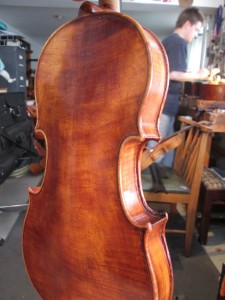
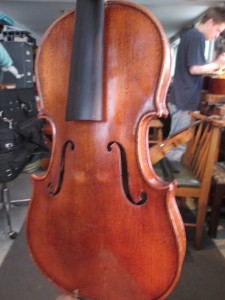
Category Archives: Uncategorized
Working on the cello to be played solo at state funeral
Spent an interesting day in the shop working on the cello to be played at the state funeral for the son of Vice President Biden. Interesting to quietly work on something that will be used in a vast, stately ,solemn event where the most important people in our world will be attending. It reminds me of the way that art begins in the silence and pushes out towards an end that you don’t often know….sometimes even dizzying heights….but wherever your work ends up contributing its spirit…for me it always grows out of the authentic , everyday and grounded work at the bench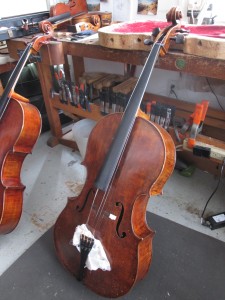
An interesting Moennig era memory
It has been over 5 years since The Shop closed and every once in a while while working at the bench memories come back. One particular moment stood out for me the other day. My good friend Jesus Morales showed me his new cello by the Swedish maker Peter Westerlund. It is a copy of the world renowned cello played for many years by Orlando Cole – The “Sleeping Beauty” by Domenico Montagnana made in 1739.
It brought back the time when Mr Cole ( I could never call him Landy) brought his magnificent cello to us to sell on his behalf. Not only was it a wonderful opportunity to work on it and live with it for a while…it was a heady time when great cellists from all over the world came to explore it. One memorable moment in it all was the arrival of Heinrich Schiff from Austria ( who became the eventual owner of the cello). Mr Schiff brought with him the beautiful Mara Stradivari cello of 1711 that he was playing at the time. While trying the Montagnana cello upstairs in the try out room he left his cello for all to admire. While looking it over I noticed the top had a ripple effect that was curious….it was strange but not too alarming. Many instruments of this age have arching abnormalities that come from centuries of strain.When I had a chance to mention it to him he mentioned the unbelievable story that the cello had been on a river ferry in South America in the 1960’s that had sunk!….and that the cello had been submerged for a few days in the drink!
As I then learned by looking up the cello……”When hauled up from the depths in its case the the cello was said to be unrecognizable and completely in pieces”…..I should say! It was then taken to the famous W E Hill & Son shop in London for a heroic restoration. Needless to say I then looked at the cello much more closely for any and all signs of the work done to resucitate this drowned cello. As one looked knowingly you saw signs and hints….but the overall effect was to marvel at the painstaking skill that was lavished on wrestling this thin wooden skin back into shape. It was a dramatic example of the fact that these fine old instruments are often now a collaboration of the great makers who produced them and the great crafstman that keep them living ( and sometimes do CPR!)
When Mr Schiff took the cello to Austria part of the great Cole legacy went with him….but its interesting how it comes back indirectly. Ricardo Morales, the principal clarinet of the Philadelphia Orchestra, is passionate about the violin. He has acquired a beautiful Telesphore Barbe from me for his wife Amy Oshiro, who also plays in the Orchestra. He frequently talks to any of the visiting soloists about the makers they know in Europe and around the globe, He heard players talk of Peter Westerlund from Sweden and began collecting his work. Schiff had become friendly with Westerlund and had invited him to his home in Austria to view his impressive collection of cellos (see Westerlunds site) The one cello in the collection that stood out was the “Sleeping Beauty” and that is the cello he beagn to make….Well Jesus came to admire Westerlunds work through he violins of Ricardo and has become the owner of one of his cellos. So now I get to work on and admire a beautiful, faithful copy of the legendary Mr Cole’s broad, dark and gorgeous Montagnana.
A great night of cello work at the bench
Neck graft on Didier Nicolas violin c. 1860
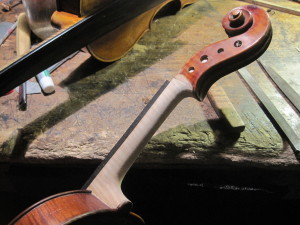
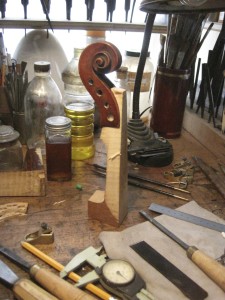 Its always enjoyable to do a neck graft….its a fascinating mixture of old and new. Old instruments need a neck graft for a variety of reasons – old necks were shorter than they are today -they were set at a lower angle – they wear from playing by the hand eroding the wood etc. In this case the old neck was too short and set too low.
Its always enjoyable to do a neck graft….its a fascinating mixture of old and new. Old instruments need a neck graft for a variety of reasons – old necks were shorter than they are today -they were set at a lower angle – they wear from playing by the hand eroding the wood etc. In this case the old neck was too short and set too low.
First the scroll is cut off the old neck – the pegbox is then chiseled out with the sides feathered to receive the new wood of the graft. The graft is fashioned in a wedge shape so that you fit the scroll down through the tapered graft. Its crucial that all surfaces fit exactly – in the photo you can see that I am almost there
Once the scroll is glued to the graft – the pegbox is chiseled out – the fingerboard is glued on and the neck stock is prepared to set into the corpus of the violin. When the varnish is restored it should look as if nothing has happened …and this fine, old French violin will perform better than ever….
An interesting instance of the collaborative nature of the many hands that enable an old instrument to have a long vibrant life.
Great cello by Sebastian Vuilluame
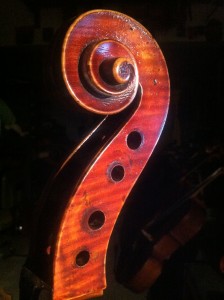
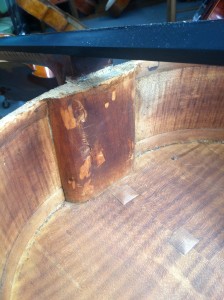
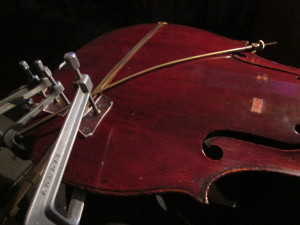 This beautiful cello suffered a fall and developed a long crack on the top….a great time to get intimately acquainted with this French masters work. He was the nephew of the illustrious J B Vuilluame
This beautiful cello suffered a fall and developed a long crack on the top….a great time to get intimately acquainted with this French masters work. He was the nephew of the illustrious J B Vuilluame
The elegant scroll shows the gorgeous, deep red varnish and dramatic crackle worthy of the Vuilluame legacy.
The original ( rather skimpy) top block shows a rather shallow neck set and the characteristic French way of having a low overstand and sharp angle to achieve the right projection.
Yearly hiking trips out west!
Every year I go out west with 4 friends and do a week long hiking trip in some beautiful, rugged mountainous spot. I love living in the heart of a big city…but… it sure makes you enjoy getting out of it. This years trip was to the Mt Ranier area of the Cascade mountains….breathtaking hiking above the tree line.
in some beautiful, rugged mountainous spot. I love living in the heart of a big city…but… it sure makes you enjoy getting out of it. This years trip was to the Mt Ranier area of the Cascade mountains….breathtaking hiking above the tree line.
Last years trip was to the Aspen area of the Rockies in the fall just as the snow was starting to build . Great climbing around the famous ” maroon bells” –
. Great climbing around the famous ” maroon bells” –  and the Continental D
and the Continental D
 ivide.
ivide.
The year before that was an unforgettable backpacki ng trip through the Grand Canyon…whiuch included an all day hike out to Clear Creek canyon to see an Indian farming settlement dating back a thousand years -where there is still evidence of their stone tools
ng trip through the Grand Canyon…whiuch included an all day hike out to Clear Creek canyon to see an Indian farming settlement dating back a thousand years -where there is still evidence of their stone tools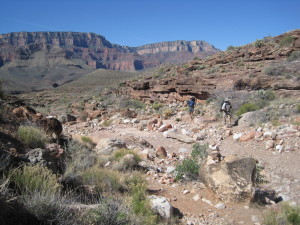

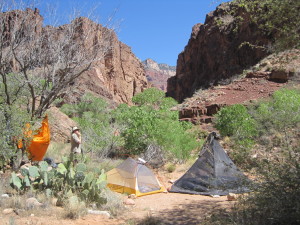

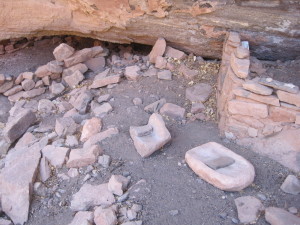 .
.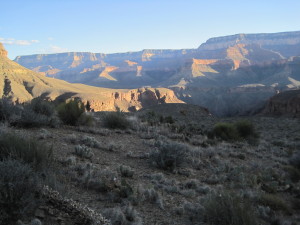

I’ll never forget crossing the Colorado river on the long foot bridge at dawn as we began our hike out of the canyon.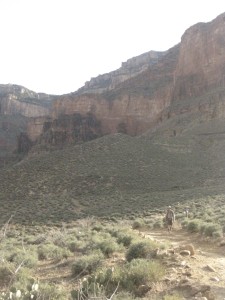


Beautiful Nicolo Amati from the 1680’s
This fine violin is the first violin in a prominent quartet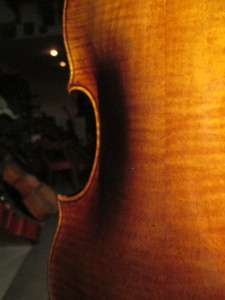 . It has the beautiful grace and delicacy of line that we always admire in the Amati workmanship. The sculptural arching of the top and back have an organic power that you often see copied in an antiseptic ,anemic fashion
. It has the beautiful grace and delicacy of line that we always admire in the Amati workmanship. The sculptural arching of the top and back have an organic power that you often see copied in an antiseptic ,anemic fashion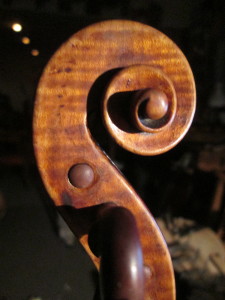 . The finely wrought scroll has the sharp clarity and living feel of a work of nature.
. The finely wrought scroll has the sharp clarity and living feel of a work of nature.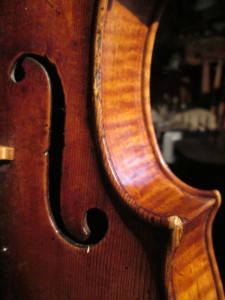 The bold F hole has a remarkable sinuous power for something so curvy and delicate. Another testament to this instruments ageless quality is the fact that it still has the Wurlitzer bridge on it that has been on for probably 50 years!
The bold F hole has a remarkable sinuous power for something so curvy and delicate. Another testament to this instruments ageless quality is the fact that it still has the Wurlitzer bridge on it that has been on for probably 50 years!
Its always satisfying working on an instrument like this….something made in Cremona when Stradivari was a young man….and though the legend of him working in the Amati shop has been called into question…its a great story to think this could have been made in the shop when he was there….and maybe even had his hands on it and studied it as an example of violin making at its very best.
Noble, old Italian cello
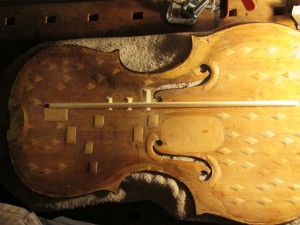 This beautiful cello dates from the late 1600’s…. and can be placed in Cremona…though not to a particular maker.
This beautiful cello dates from the late 1600’s…. and can be placed in Cremona…though not to a particular maker.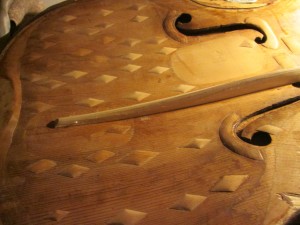 As you can see this instrument has been through quite a journey and it has taken the work of many hands to keep it performing at its high level.
As you can see this instrument has been through quite a journey and it has taken the work of many hands to keep it performing at its high level.
My contribution to this ongoing process was to remove the bass bar in order to glue a crack under it ….then after the gluing, fit studs to secure the crack….then fit a new bass bar that is notched to fit over the studs…which is rather tedious and painstaking. The photos show my bar already in and the beginning of shaping it – also the studs are glued in roughly- and in the process of being worked down to their final shape.
This great cello has been labored over for many generations….its a special feeling to add to this ongoing story and contribute to preserving this work of art and enable it to perform at its best. I
t puts me in mind of a quote by Winston Churchill.. ( quite an amateur painter) who was speaking about art at a state dinner was during WW II…. when someone confronted him that” in this difficult time …art was not going to save the world “….he said ” perhaps….but without it there is precious little worth saving”
This great cello is played by Derek Barnes in the Philadelphia Orchestra.
Fine examples of teacher and pupil
Two beautiful violins are shown here – one by Telesphore Barbe and the other by Victor Audinot. Barbe was at one time the principal worker for Vuilluame (as he boldly states on his label) and he was the mentor of 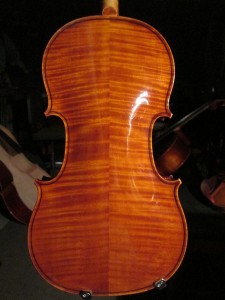 Victor Audinot
Victor Audinot
Pictured here are a beautiful Strad (Messiah) copy by Barbe and a stunning Guad copy by Audinot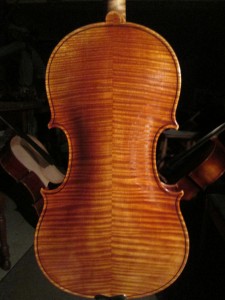 . Both these fine instrments are being offered for sale
. Both these fine instrments are being offered for sale